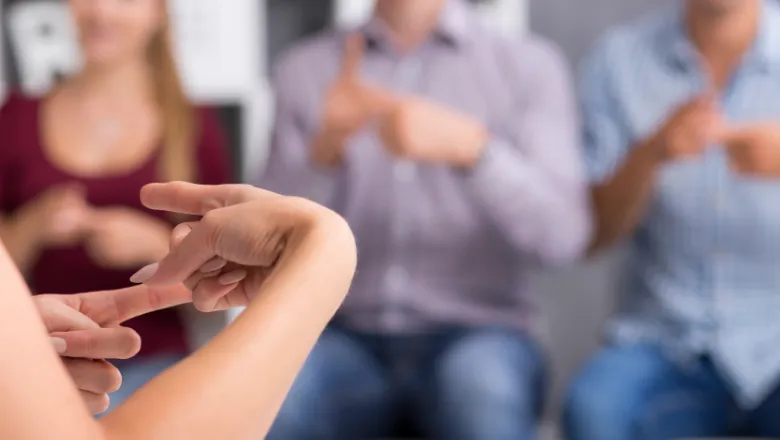I am so pleased that we were taught some basic BSL as part of my course. The session really gave me a taste of the language and has motivated me to seek out opportunities within King’s to learn more. That’s how I found out about the KCL BSL Society and their weekly practice sessions, as well as the discounted Level 1 BSL course, which I have now signed up to. As a future children’s nurse, it is so important for me to be able to communicate with children, young people and their families in a way that they need me too.
Sarah
10 December 2021
Signing up for inclusivity: learning British Sign Language as a nursing student
Nursing student Sarah Cooper reflects on her experience of learning BSL as part of her course, and the importance of knowing some sign language basics as a future children’s nurse.

Sarah Cooper, a Children’s Nursing student at King’s, has praised her course for incorporating a session on British Sign Language (BSL). During a one-hour session earlier this year, Sarah and her fellow students learnt the basics of BSL, including how to sign the letters of the alphabet, introduce themselves and ask for a patient’s name.
This initial session inspired Sarah to take her knowledge one step further, signing up for weekly BSL lessons and getting involved with the KCL BSL Society. She has no doubts that increasing her knowledge of the language will prove useful in her future nursing career.
The session forms part of first-year students’ simulated practice, and was the brainchild of Laura Gilmore, Lecturer in Nursing Education in the Department of Child and Family Health at the Florence Nightingale Faculty of Nursing, Midwifery & Palliative Care. The simulated practice focuses on developing the students’ professionalism and communication skills, and Laura wanted to make sure students were able to communicate with patients and families who use sign language, even at a basic level.
I’m not fluent in BSL myself, but even knowing the basics has been hugely helpful to me during my own career. Being able to say hello and introduce yourself to children and families who communicate using sign language while they are in a clinical environment can help to ease their anxiety, as well as make them feel more respected.
Laura
The session is always warmly welcomed by students, who approach it with enthusiasm and, like Sarah, often leave inspired to learn even more.
We try to make the session as fun and engaging as possible. To learn the alphabet, we use the alphabet song and have students sign along to it. When they start to get the hang of it, we run the song at double speed to see if they can keep up. We also have students work in pairs to introduce themselves to someone they don’t know, so they have to identify someone’s name through sign language. It’s a very engaging session and we’re always so pleased with the positive feedback we receive.
Laura
For Sarah, the session left her feeling proud to be a King’s nursing student and that the university takes diversity and inclusion seriously.
“I find it inspirational that the Faculty made the decision to incorporate a BSL session into the course, even though it’s not a requirement. To me, it demonstrates that King’s takes inclusion seriously and I feel proud to be on the programme and a future King’s nurse. This won’t just have an impact within the university – but as the next generation of nurses it will also impact the nursing profession, healthcare and the children, young people and families we will have the privilege to care for once qualified.” - Sarah
A simple introduction is the first step on the ladder in any therapeutic relationship and the #HelloMyNameIs campaign, founded by Dr Kate Granger MBE, highlights the importance of compassionate and person-centred communication. The campaign message resonates strongly with Sarah, and adds another layer of importance to learning BSL as a future healthcare worker.
It’s not just about being able to introduce myself and ask someone for their name, it’s about bringing my human self into the therapeutic relationship, putting them at the heart of their care and making sure they have the best possible experience. I feel quite strongly about the importance of this, so I’ll be wearing my ‘Hello, my name is’ badge while on placement. That way, I can support the campaign and have it as a nice reminder of the qualities I would like to embody as a nurse.
Sarah
Before turning her focus towards nursing, Sarah spent several years working in the advertising industry as a client director. Making the decision to leave an established career to retrain as a nurse and start university as a mature student was not easy, but Sarah is thrilled to be joining a profession that aligns with her personal values, and one that will give her a huge sense of fulfilment, as she serves children, young people and their families at important times in their lives.
Sarah has just finished her first clinical placement, and says she was pleasantly surprised by the amount of caring responsibility and opportunity she was given as a first-year student– and has met some incredibly inspiring children and families that have fuelled her passion for the profession. She is now back at university, attending her final lectures of the year, and looking forward to continuing her studies in term two.

